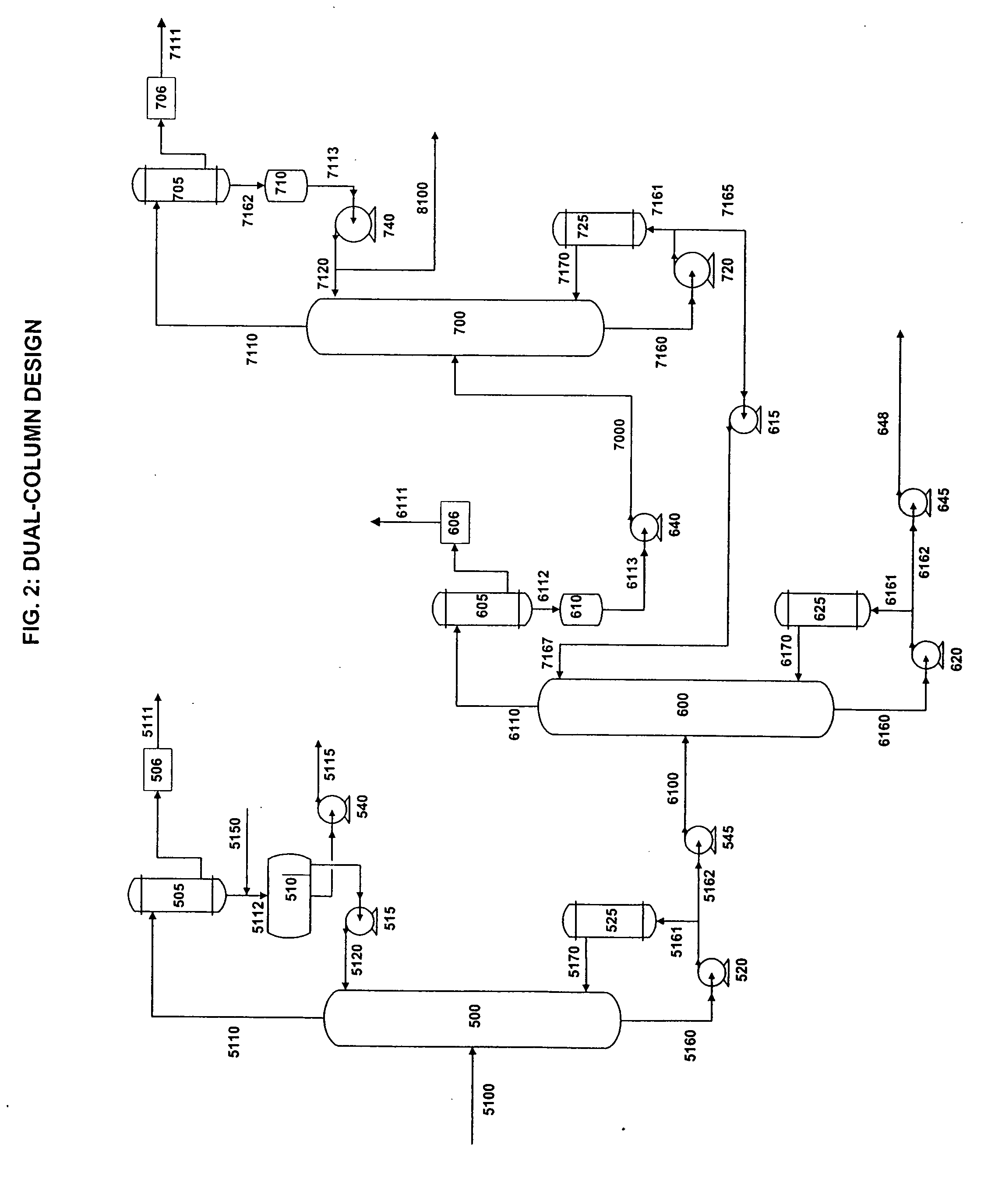High capacity purification of thermally unstable compounds
- Summary
- Abstract
- Description
- Claims
- Application Information
AI Technical Summary
Benefits of technology
Problems solved by technology
Method used
Image
Examples
example 1
[0113] Acrylic acid was produced in accordance with the process diagram illustrated in FIG. 1. With reference to FIG. 1, acrylic acid-containing aqueous feed solution (100), azeotropic distillation column (1), azeotropic distillation column overhead vapor (110), condenser (5), aqueous-organic separator (10), azeotropic solvent containing reflux phase (120), aqueous containing distillate phase (130), azeotropic dehydration column bottoms (180).
[0114] Azeotropic distillation column (1), had the following physical characteristics:
[0115] 1. 172 in. ID column
[0116] 2. 71 dual-flow trays
[0117] 3. Lower trays had 24% open area
[0118] 4. Upper trays had 20% open area
[0119] Acrylic acid-containing aqueous feed solution (63-67 wt % acrylic acid, 2-4 wt % acetic acid, 1-3 wt % impurities, and 26-34 wt % water) was fed to column (1). Overhead pressure in column (1) was set to 110 mmHg (2.1 psi) absolute and total pressure drop through the trays was held to 120 mmHg (2.3 psi) to minimize bo...
example 2
[0121] Azeotropic distillation column (1) had the following physical characteristics:
[0122] 1. 172 in. ID column
[0123] 2. 54 dual-flow trays
[0124] 3. Lower trays had 16-18% open area
[0125] 4. Upper trays had 14-20% open area
[0126] Acrylic acid-containing aqueous feed solution (63-67 wt % acrylic acid, 2-4 wt % acetic acid, 1-3 wt % impurities, and 26-34 wt % water) was fed to column (1). Overhead pressure in column (1) was set to 110 mmHg (2.1 psi) and total pressure drop through the trays was allowed to rise to 140 mmHg (2.7 psi) resulting in a bottoms temperature of 111° C. (232° F.). Pressure drop per tray was increased to 4-6 mmHg (0.08-0.12 psi) by installing a plurality of lower open area trays in column (1).
[0127] Bottoms product (180) contained: 94-96 wt % acrylic acid, 4-6 wt % acrylic acid dimer, and 0.05-0.1 wt % acetic acid. Aqueous distillate product (130) contained: 1-2 wt % acrylic acid, 6-8 wt % acetic acid, and 90-93 wt % water. Tray efficiencies for the 16-18...
example 3
[0128] An existing acrylic acid column was retrofit (modified, revamped, retrofitted) to achieve a first retrofit embodiment and a second retrofit embodiment of the present invention. The “after retrofitting” column of table 5 contains the data of the Second Retrofit Embodiment. The operating data from before and after modification is found in the table below.
[0129] Column trays in this example are of the dual flow type. The initial modifications recently in the first retrofit embodiment were as follows: trays 3, 5, 7, 9, 11, 13, 15, 17, 19, 21, 23, 25, and 27 removed (71 original total trays). Installed 16.24% hole area tray panels (w / ½″ ID holes) on trays 2, 4, 6, 8, 10, 12, 14, 16, 18, 20, 22, and 24. Installed 20.00% hole area tray panel (w / ½″ ID holes) on tray 26.
[0130] The final modifications resulting in the second retrofit embodiment were as follows: Removed 16.24% hole area tray panels (w / ½″ ID holes) on trays 14, 16, 18, 20, 22, and 24 (72 original total trays). Installe...
PUM
| Property | Measurement | Unit |
|---|---|---|
| Length | aaaaa | aaaaa |
| Pressure | aaaaa | aaaaa |
| Pressure | aaaaa | aaaaa |
Abstract
Description
Claims
Application Information
 Login to View More
Login to View More - R&D
- Intellectual Property
- Life Sciences
- Materials
- Tech Scout
- Unparalleled Data Quality
- Higher Quality Content
- 60% Fewer Hallucinations
Browse by: Latest US Patents, China's latest patents, Technical Efficacy Thesaurus, Application Domain, Technology Topic, Popular Technical Reports.
© 2025 PatSnap. All rights reserved.Legal|Privacy policy|Modern Slavery Act Transparency Statement|Sitemap|About US| Contact US: help@patsnap.com



